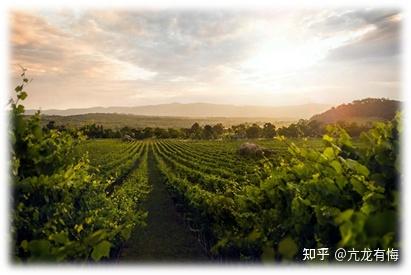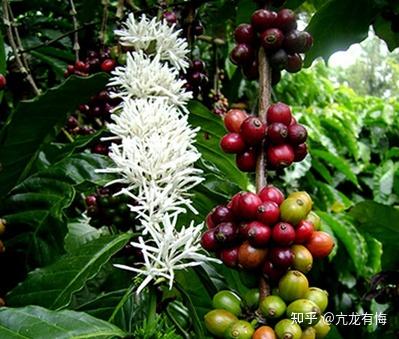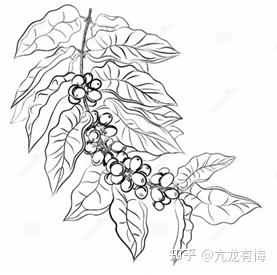闲聊咖啡--咖啡的种植环境

咖啡栽培所需要的5个条件:气候、阴影、地形、土壤、经济状况!
Essential growth conditions required for the cultivation of coffee are as follows:
1. Climate 2. Shade 3. Topography 4. Soils 5. Economic Conditions!
▸ 气候 Climate:
咖啡是一种热带植物,也生长在亚热带气候。咖啡树需要热量、湿度和充足的降雨。咖啡栽培需要以下温度和降雨条件。
Coffee is a tropical plant which is also grown in semi-tropical climate. The coffee tree requires heat, humidity and abundant rainfall.The following temperature and rainfall conditions are necessary for coffee cultivation.
a. 温度 Temperature:
咖啡的平均温度要求在20°-27°C之间。尽管在阿拉伯半岛,咖啡在白天的温度超过32°C时生长。生长最快的是在炎热的雨季和凉爽的旱季浆果成熟并准备采摘。明亮的阳光和温暖的天气是收获的必要条件。
Coffee requires an average temperature between 20°-27°C. Although it grows in day temperature over 32°C in the Arabian Peninsula. Growth is most rapid during hot rainy season and during cool dry season berries ripen and ready for picking. Bright sunshine and warm weather are necessary for the harvesting.
b. 降水 Rainfall:
咖啡需要充足的降雨量,即每年100至200厘米。因此,接受地形降雨的山坡最适合种植咖啡。
Coffee needs abundant rainfall, i.e., 100 to 200 cm annually. The hill slopes which receive orographic rainfall are thus best for coffee cultivation.

▸ 阴影 Shade
阳光直射对咖啡植物有害,因此它们被种植在香蕉等高树的树荫下。在巴西,豆科植物不仅能提供荫凉,还能使土壤富含氮。
Direct sunlight is harmful for coffee plants; therefore, these are planted under shade of taller trees such as bananas. In Brazil, leguminous plants are used which not only provide shade but also enrich soil with nitrogen.
▸ 地形 Topography
一般来说,咖啡种植在高度在600到1800米之间的斜坡上。斜坡适合咖啡是因为这些斜坡排水良好,也较凉爽。水分停滞对咖啡植物非常有害;因此,山坡最适合它。
Generally, coffee is grown on slopes having height between 600 to 1,800 metres. The suitability of slopes for coffee is because these are well-drained and also cooler. Water stagnation is very harmful for coffee plants; therefore, hill slopes are best suitable for it.
▸ 土壤 Soils
土壤是咖啡种植的主导因子。理想的土壤是具有良好的地下排水系统,且易于施工的土壤。土壤中含有腐殖质和其他含氮物质是一个优势。
Soil is the guiding factor in coffee plantation. The ideal soil is one with a good sub-surface drainage, and one that is easily workable. The presence of humus and other nitrogenous matter in the soil is an advantage.
▸ 经济状况 Economic Conditions:
a. 劳动工人 Labour
咖啡种植需要大量劳动力,因为咖啡是手工采摘的,因为迄今为止还没有开发出任何机器来完成这项工作。除此之外,种植园一年四季都有很多工作要做,比如整地、移植、耕种、修剪、除草,当然还有收获。
Coffee cultivation required a large number of labour forces because coffee is to be hand-picked, as no machine has so far been developed to do this job. Apart from this, there is much work to be done on plantation all around the year such as field preparation, transplanting, cultivating, pruning, weeding and of course harvesting.
b. 资本 Capital
种植咖啡是一项资本密集型活动。这主要是因为在最初的三到四年里,咖啡种植园的收益为零,支出更多。因此,咖啡种植需要巨额资金。
Plantation of coffee is a capital-intensive activity. This is more due to the fact that during first three to four years returns from coffee plantation are nil and expenditure is more. Therefore huge capital is required for coffee cultivation.
c. 运输 Transport
一个成功的咖啡种植园需要一个良好的内部和外部运输网络。内部铁路和公路运输有助于从产地收集咖啡,而配送则通过海运和空运,有时也通过陆路。
For a successful coffee plantation a good network of both internal and external transport is necessary. The internal rail and road transport helps in collection of coffee from producing areas, while distribution is done either by sea and air routes or sometimes by land routes.
d. 市场 Markets
咖啡正在走向国际市场。维护国际市场是必要的,因为当今市场竞争激烈。同样,市场波动也会直接影响咖啡的产量和价格。
Coffee is having international market. It is necessary to maintain international market because nowadays there is much competition in the market. Similarly market fluctuations also have a direct impact on the production and price of coffee.

如何提高土壤质量
How to Improve Soil Quality
种植强壮、健康的咖啡树需要平衡几种元素:阳光、水、风和土壤养分。然而,当谈到土壤质量时,有许多误解。
Growing strong, healthy coffee trees involves balancing several elements: sun, water, wind, and nutrients from the soil. However, when it comes to soil quality, there are many misconceptions.
健康的土壤是咖啡种植的一个基本方面,作为一个希望从你的作物中获得最高质量和产量的农民,你不能忽视它。
Healthy soil is a fundamental aspect of coffee plant production, and as a farmer looking to get the maximum quality and yield from your crop, you can’t afford to ignore it.
为了确保你能从你的耕作努力中获得最好的结果,你需要确保你的土壤中含有正确数量的特定养分。这些营养素是什么,它们如何影响你的土壤质量,以及如何避免可能对你的咖啡产量产生负面影响的错误。
In order to make sure you get the best possible outcomes from your farming efforts, you need to ensure that specific nutrients are present in your soil in the correct quantities. Here’s what these nutrients are, how they can impact your soil quality, and how to avoid mistakes that could negatively impact your coffee production.

宏微量营养素的重要性
The Importance of MACRO & MICRONUTRIENTS
成功开发咖啡植物需要17个基本要素。任何一种植物的缺乏都会对植物的生长发育和产量产生负面影响。
There are 17 essential elements required for successful coffee plant development. A shortage of any one of them can negatively impact your plant development and yield.
咖啡植物从周围的空气和水中吸收碳、氢和氧,从种植的土壤中吸收氮、钾、磷、钙、镁和硫。这九种元素被称为大量营养素,咖啡植物需要大量营养素才能茁壮成长。
Coffee plants receive carbon, hydrogen, and oxygen from the surrounding air and water, and receive nitrogen, potassium, phosphorus, calcium, magnesium, and sulfur from the soil where they’re planted. These nine elements are called macronutrients, and large quantities are needed for a coffee plant to thrive.
咖啡植物也需要某些微量营养素,但数量要少得多。这些元素包括铁、锌、铜、锰、硼、氯和钼。一些植物也需要镍。
Certain micronutrients are also needed by coffee plants, but in much smaller quantities. These include iron, zinc, copper, manganese, boron, chlorine and molybdenum. Some plants also require nickel.

